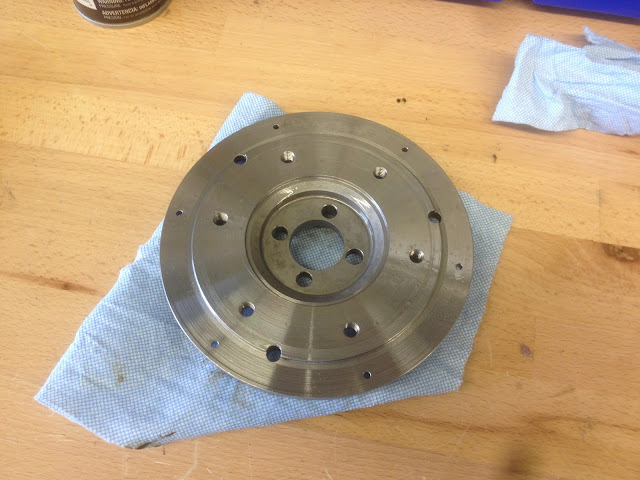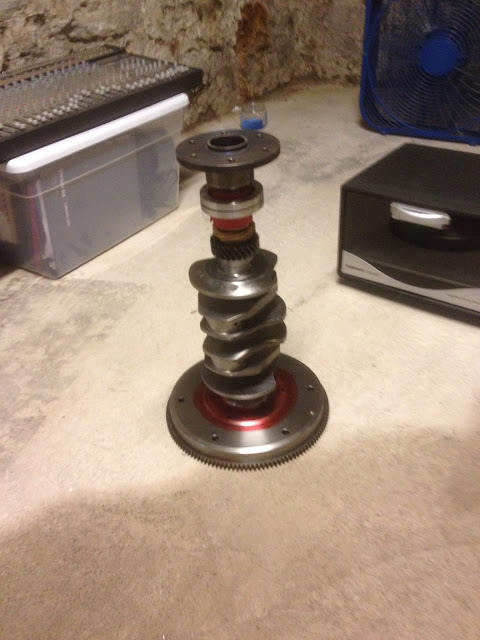It took a lot of work, but I got all four dowel pins out without damaging the crank. The two I put in came out easily enough with some vise grips and a bit of twisting and pulling... the two that were in from before were another story entirely. Nothing would touch them, including the hardened jaws of a *nice* set of vise grips. (Those are no longer a nice set of vise grips, by the way.) In the end, I discovered why machinists have drill bit sets up to half an inch with just a couple thou of difference all the way up...
...It's because hardened steel pins can't be drilled out with big steps between bit sizes! It took me a solid hour and a half to drill each pin out. However, both of them twisted out right before I broke through the wall of the pin (after a couple good taps with a hammer on the side of the pin to break it up a bit.)
I checked the face on a dial indicator, and at most it's out a single thousandth at the edge. That's about an inch from center, which means that might account for about 5 thousandths at the edge of the flywheel.... which means something else is amiss. I checked the flywheel by placing it on an indexer, supported by placing a tight tolerance block between the indexer and the mating face on the flywheel. Spin the indexer, check for runout.... I forget what I got, but it was insignificant (which is why I forgot it. :D) I was pretty puzzled at that point. However, since the pins were out of the crank, I was able to rotate the flywheel on the crank. How does that help us? Well, before I pulled the dowels, I'd marked on the flywheel exactly *where* the runout was, as well as *how much.* When I put the flywheel back on after the pins were out, I lined it up pretty close to where it was originally... and got pretty much the same results. (I didn't use an indicator, as I was less interested in how much it was out as *where* it was out.... and it was wobbling pretty obviously.) Ok, repeatability, that's good. So I rotated the flywheel 180 degrees and tried again. If it was the flywheel, that should've made no difference; the marks on the flywheel still should have been correct. If it was the crank face that was out, then the marks on the flywheel should have been exactly (or close to) opposite what the flywheel was showing the second time around.
So what did I find? Well.... actually, it was about 70 degrees off from where it was originally. I didn't know what to make of that, until I started taking careful measurements of everything. What I found was that the flywheel had a bit of a radius where it mated with the crankshaft, and the crankshaft did not have that radius. I think what's happening is that there's a tiny bit of play between the *side walls* of the flywheel and the crankshaft, and the radius causes the face of the flywheel to be tighter than the crankshaft can fit into. Add the radius and a little bit of slop and, unless the radius on the flywheel and the edge on the crankshaft are perfectly uniform and smooth, odds are the flywheel just isn't seating fully and is staying at a bit of an angle. The fix is simple; just cut a matching radius (or, much easier, a slightly relieved chamfer) on the crankshaft. The side walls and dowel pins will still locate the flywheel, and the face where the two meet won't lose much area. I like that idea better than cutting a sharp corner into the flywheel.
I should mention, the reason that this is an easy fix is because I recently picked up a Jet 9x20 metal lathe. Just as soon as I finish getting that set up in the basement, this will be a pretty straightforward job. I'll be spending my evenings this week cleaning it up and, as soon as my insert tooling shows up next week, I'll be making chips and breaking tools. Also touching up airplane engine parts.
I also got my oil galley plugs straked in place so they can't rotate out. I found one of my case savers was loose, so I used some red LocTite, filed a notch in it, and straked that in place as well.
The last thing I wanted to do today was check my connecting rod bearing clearance. If you've never heard of PlastiGauge, you're in good company; none of the auto parts stores I went to had ever heard of it either. I ended up at a local NAPA, a company I spent 6 years working as a counterman for, and gave the kid at the counter the part number I remembered as being correct. "Huh, it says we've got 12 in stock. What is it again?" It comes from the warehouse packaged as a dozen, so I guess it shouldn't surprise me he'd never heard of it; he'd never sold any of it. Anyways, PlastiGauge is a kind of plastic-y wax string that's very precisely formed. A strip of it is placed between two surfaces you want to check clearance on, and those two surfaces are brought together however they will be brought together during final assembly. In this case, those surfaces are the connecting rods with bearings installed, and the crankshaft. Blurry picture, but the green little stripe in the middle of the white grease is the PlastiGauge before the con rod is tightened....

...And after:
The lighting was pretty awful. However, I can tell you that the strip of green that's *not* a weird reflection is the one above the .0015" mark. Basically, that wax gets squished to different widths based on how much clearance is available, and the package the wax comes in has a gauge on the side to check it with. All four journals had *exactly* the same width as the .0015" mark, and they were all very even stripes from one side of the journal to the other. (If the journals or the con rods had any taper, that would've shown up as a tapered stripe.) The specs for this engine are 0.0008-0.0025, so I'm smack in the middle of where I want to be. Any wear is going to cause that clearance to open up, and I've got a solid thousandth of an inch for it to open up before I make it out of the range I want to be in.
I'll putz around with little things here and there, but mainly I'll be setting up that lathe and taking some test cuts to get to know it. I've got to do my touch up on the crankshaft, and a couple other things, and then I can start test assembling everything.























































